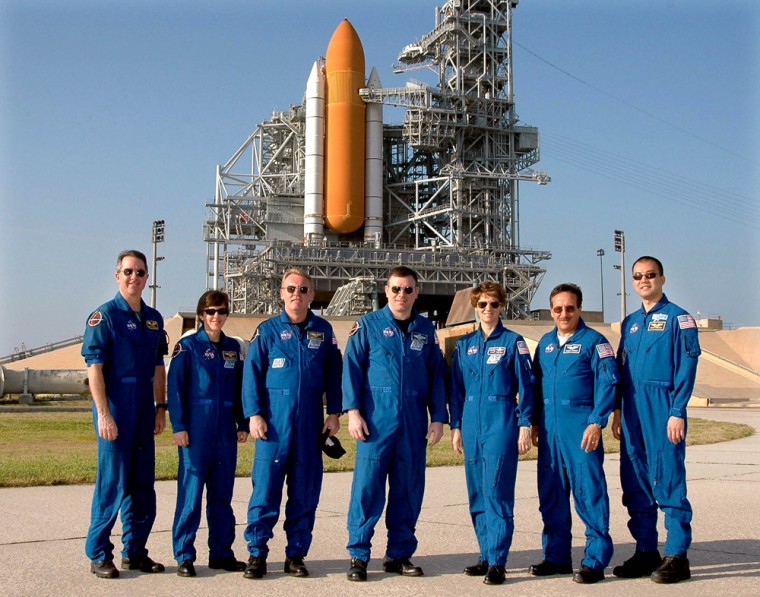The shuttle Discovery's orbital repairmen plan to use the extra time before their launch -- now expected for July -- to hone NASA's new techniques for fixing damage to the shuttle, crew members said Tuesday. They may even add some new tasks to the agenda.
The current plan calls for spacewalkers to try out at least two new tools — an applicator that daubs repair material onto tiles and a caulk gun for the wings' reinforced carbon-carbon heat-shielding panels. Two other repair techniques — screw-on overlays and a bolt-on "plug" for gaps in the RCC panels — are to be demonstrated inside Discovery's crew cabin, rather than during the mission's three scheduled spacewalks.
Yet another technique, which calls for filling in small damaged areas with an expandable goo, has not yet been cleared for testing in space.
Discovery's 12-day mission is aimed at delivering supplies to the international space station as well as testing the methods for shuttle inspection and repair that were developed after the Columbia tragedy in 2003.
Japanese astronaut Soichi Noguchi said he and his fellow spacewalker, Stephen Robinson, would put in some additional practice time for extravehicular activity now that the launch has been delayed from late May to the July 13-31 time frame.
"We're going to use these two months wisely to have some extra underwater training, plus we might have some time to look at the other possilble repair techniques like the overlay," he told reporters during a crew news conference at Discovery's launch pad, held in conjunction with this week's countdown rehearsal.
Another crew member, Charles Camarda, agreed that the extra time could help the crew gain more confidence in all the repair techniques. "I think we would be able to mature some of these concepts, like the overlay concept, and possibly the plug and the small-area repair concept," he said.
But he emphasized that changing the agenda for the spacewalks was up to NASA's shuttle program office rather than the crew. "We have these two months to do that in, and it's really up to the program office ... to prioritize what they want to do next," he said.
Time for tank modifications
The launch date was moved back for safety concerns, to give NASA time to bring the shuttle back into its Vehicle Assembly Building and add another heater to a critical area of the external fuel tank. Such a modification would reduce the potential for ice to form and break off during launch.
Engineers had already modified the tank significantly to reduce the risk of foam insulation coming off the tank and damaging the shuttle. It was just such a debris strike that investigators believe led to the catastrophic breakup of the shuttle Columbia during its re-entry on Feb. 1, 2003. All seven of Columbia's astronauts died in the tragedy, which led NASA to ground the shuttle fleet.
Last week, shuttle managers expressed concern about the lingering possibility that ice might build up from the liquid-oxygen feedlines on the supercooled tank, and shuttle commander Eileen Collins said NASA was right to delay the launch because of such concerns.
"We cannot fly with anything defined as an unacceptable risk, and we are not at the point where we can say that is definitely not the case," she said. "So at that point when we can say there are not any unacceptable risks, we will be ready to fly."
Collins said she and the rest of the crew would use the next few weeks "to make ourselves even better."
Among other highlights from Tuesday's news conference:
- Collins told MSNBC.com that the criteria for calling off or aborting a shuttle launch have not changed much because of the Columbia investigation. "I do know that we have cameras out here basically all along the Space Coast ... Some of them have been added to the launch commit criteria; otherwise, I think our launch countdown is going to be pretty much the same."
- Pilot Jim Kelly almost stole the show with his description of the liftoff as a "roller coaster" and the landing as a "runaway train." Afterward, Collins remarked, "We're getting excited just listening to him."
- Collins said "we do have a plan" to honor Columbia's fallen crew during Discovery's mission, but declined to provide specifics. "I will say we have a picture of the crew that we have had for a while, that we will be displaying on the mission," she said.
This week's practice session in Florida, known as the terminal countdown demonstration test or TCDT, reaches its high point Wednesday morning with a dress rehearsal of the final hours before launch. The crew is then due to fly back to Texas just as they came, aboard NASA's T-38 training jets.
Later this week, NASA will announce the time frame for rolling the shuttle back to the Vehicle Assembly Building in order to do the fuel tank modifications.
